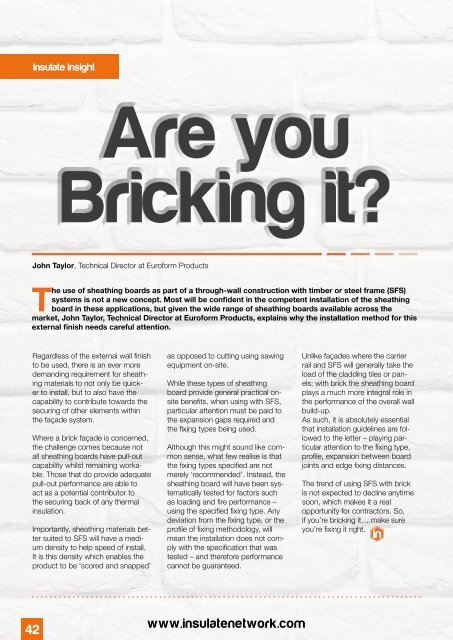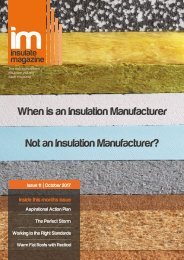Insulate Magazine Ecobuild 2018 Special Edition
Ecobuild 2018 special edition of Insulate Magazine, featuring Insulate exclusive articles and excellent insulation insight from Mauer, BBA, Insulation Superstore, Isover, NIA, Netsezch, 3M, IMA, Quinn, MIMA,
Ecobuild 2018 special edition of Insulate Magazine, featuring Insulate exclusive articles and excellent insulation insight from Mauer, BBA, Insulation Superstore, Isover, NIA, Netsezch, 3M, IMA, Quinn, MIMA,
Create successful ePaper yourself
Turn your PDF publications into a flip-book with our unique Google optimized e-Paper software.
<strong>Insulate</strong> Insight<br />
Are you<br />
Bricking it?<br />
John Taylor, Technical Director at Euroform Products<br />
The use of sheathing boards as part of a through-wall construction with timber or steel frame (SFS)<br />
systems is not a new concept. Most will be confident in the competent installation of the sheathing<br />
board in these applications, but given the wide range of sheathing boards available across the<br />
market, John Taylor, Technical Director at Euroform Products, explains why the installation method for this<br />
external finish needs careful attention.<br />
Regardless of the external wall finish<br />
to be used, there is an ever more<br />
demanding requirement for sheathing<br />
materials to not only be quicker<br />
to install, but to also have the<br />
capability to contribute towards the<br />
securing of other elements within<br />
the façade system.<br />
Where a brick façade is concerned,<br />
the challenge comes because not<br />
all sheathing boards have pull-out<br />
capability whilst remaining workable.<br />
Those that do provide adequate<br />
pull-out performance are able to<br />
act as a potential contributor to<br />
the securing back of any thermal<br />
insulation.<br />
Importantly, sheathing materials better<br />
suited to SFS will have a medium<br />
density to help speed of install.<br />
It is this density which enables the<br />
product to be ‘scored and snapped’<br />
as opposed to cutting using sawing<br />
equipment on-site.<br />
While these types of sheathing<br />
board provide general practical onsite<br />
benefits, when using with SFS,<br />
particular attention must be paid to<br />
the expansion gaps required and<br />
the fixing types being used.<br />
Although this might sound like common<br />
sense, what few realise is that<br />
the fixing types specified are not<br />
merely ‘recommended’. Instead, the<br />
sheathing board will have been systematically<br />
tested for factors such<br />
as loading and fire performance –<br />
using the specified fixing type. Any<br />
deviation from the fixing type, or the<br />
profile of fixing methodology, will<br />
mean the installation does not comply<br />
with the specification that was<br />
tested – and therefore performance<br />
cannot be guaranteed.<br />
Unlike façades where the carrier<br />
rail and SFS will generally take the<br />
load of the cladding tiles or panels;<br />
with brick the sheathing board<br />
plays a much more integral role in<br />
the performance of the overall wall<br />
build-up.<br />
As such, it is absolutely essential<br />
that installation guidelines are followed<br />
to the letter – playing particular<br />
attention to the fixing type,<br />
profile, expansion between board<br />
joints and edge fixing distances.<br />
The trend of using SFS with brick<br />
is not expected to decline anytime<br />
soon, which makes it a real<br />
opportunity for contractors. So,<br />
if you’re bricking it… make sure<br />
you’re fixing it right.<br />
42<br />
www.insulatenetwork.com













